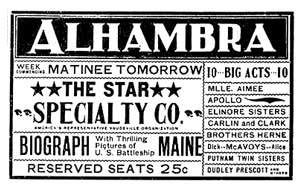Marketing Democratic Art to Working Class and Middle Class
According to the “Music and Drama” section of the March 26, 1898, Milwaukee Journal, high-class vaudeville is recognized by the theater-going public as the most popular form of amusement now in vogue, nor is there any reason why this should not be so. A vaudeville programme is made up to afford the greatest amount of pleasure to the greatest number… the most appropriate and popular number on the [Alhambra’s] bill is that marvel of perfection in instantaneous photography, the American Biograph with panoramic pictures of the ill-fated battleship Maine as she lay in New York harbor prior to her disastrous trip to Havana. Alongside of her lies the Massachusetts, the two noble vessels making an inspiring sight to all patriotic citizens. Another picture of interest to all in these times of contemplated war is that taken of the Spanish warship Viscaya, while steaming out of New York harbor, after the short visit she made us about three weeks ago enroute to Havana.

The Milwaukee Journal’s description and the accompanying advertisements are early attempts on the part of exhibitors to target middle-class consumers while also attracting an immigrant working-class audience by offering inexpensive “high-class” entertainment (see Merritt). Indeed, in January the Alhambra Theater had already included “Lumier’s Cinematographe” [sic] as part of its “$1.50 show [the ‘legitimate’ theater ticket price] for a quarter.”
The Alhambra’s utilitarian description of the vaudeville program anticipates later descriptions by film historians of film as the “democratic art” (Jowett), which Judith Mayne has criticized for “mythologiz[ing]… movie houses and nickelodeons [as] the back rooms of the Statue of Liberty” (“Two Spheres” 73) For Mayne, “consumerism [in the 1890s] offered the image of a homogeneous population pursuing the same goals – ‘living well’ and accumulating goods. The movie-theatre seemed to offer an ideal space for the exhibition of this image, for workers and middle-class people alike needed only to pay a small admission price in order to share equally in the spectacle offered on the screen” (69). Mayne thus acknowledges the ideological function of early cinema and “vaudeville [which] provided a context for the public space of the movie theater as both cross-class entertainment and as standardized performance” (77). Yet Mayne also uses the model of the immigrant filmgoer to escape the dominant paradigm of the “passive” classical Hollywood spectator:
I will argue… that while cinema quickly became an agent of the new culture of consumerism, it also kept alive fantasies of resistance to that culture. Since the mythologies of early cinema tend to portray the immigrant-spectator as little more than a passive consumer of the moving-picture show, the roles of “fantasy” and “imagination” in the film-going experience are open to misunderstanding. Fantasy may imply “escape,” but it is also a potential form of resistance, an imaginary refusal of real conditions of existence.
What one is supposed to make out of this “imaginary refusal of real conditions of existence” is somewhat unclear, yet Mayne’s argument (first published in 1982), like Gunning’s “cinema of attractions”, needs to be understood within the context of larger trends in film historiography during the late 1970s and early 80s. In the end, Mayne’s claim that immigrant spectator “actively” resisted the dominant ideology of early film images becomes highly problematic when applied to the reception and exhibition of Spanish-American War films. Indeed, if we shift or expand our focus to include ideologies of race and imperialism in addition to ideologies of ethnicity, gender, and consumerism, it becomes increasingly difficult to place politically progressive fantasies and daydreams in the minds of immigrant spectators in response to Spanish-American American War films.
